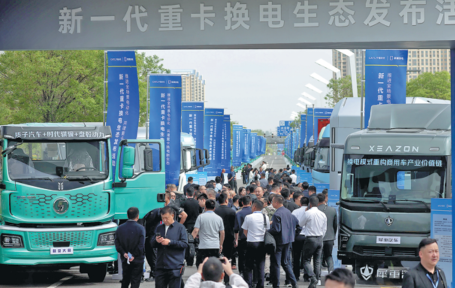NEV giants fueling shift to electric heavy trucks


Some of the biggest new energy vehicle giants are putting their efforts into heavy-duty trucks, a sector which is expected to gain momentum and become a major growth driver in China's commercial vehicle market.
The heavy truck industry will see explosive growth, with new energy models accounting for more than half over the next three years, amid the challenges and opportunities of zero-carbon transformation and logistics cost reduction, said Zeng Yuqun, CEO of CATL.
Driven by the "trade-in" policy and declining lithium battery prices, the life cycle cost advantage of electric heavy-duty trucks is becoming increasingly evident, said industry analysts, adding that the industry is expected to enter a phase of rapid growth.
Traditional heavy truck manufacturers such as Sinotruk and FAW are actively shifting to new energy powertrains, while companies including Yutong Bus, BYD, XCMG and Zoomlion are also expanding into the new energy heavy truck sector.
BYD has launched a lineup of electric heavy trucks — including tractors, dump trucks and mixers — targeting long-haul logistics and urban construction markets. FAW Jiefang, meanwhile, is accelerating its new energy truck development and reported a year-on-year increase of over 200 percent in NEV sales in early 2025.
According to data from the China Association of Automobile Manufacturers, sales of new energy heavy-duty trucks in China reached 82,000 units in 2024, a year-on-year increase of 140 percent, with a market penetration rate of 13.6 percent.
Despite this, new energy heavy-duty trucks continue to face several major challenges. Experts point out that large-scale adoption is hindered by insufficient charging and swapping infrastructure, high purchase costs, and a lack of unified battery standards.
CATL's newly released 75# battery pack adopts a chassis-based battery swap design, featuring an adjustable wheelbase and adaptive positioning capabilities. It said the battery is compatible with more than 95 percent of mainstream heavy-duty truck models.
According to CATL, its battery swap station system already enables rapid replacement across different brands and models, aiming to address current challenges such as a lack of standardized batteries and poor infrastructure compatibility.
Shanxi province issued China's first local standard for chassis-based battery swap stations in April, while a policy encourages the integration of transport and energy infrastructure. These moves are driving battery-swapping into broader commercial use.
CATL also highlighted that the first 17 swap stations will be deployed by the end of this year along the Cangzhou-Yulin Expressway, which connects the provinces of Shaanxi, Shanxi and Hebei. These stations will provide energy replenishment services for coal transport vehicles.
Data released by CATL shows that a total of 1,428 chassis battery — swapping heavy-duty trucks have already been delivered on this route, with an additional 6,900 units under signed order intentions.
Battery-swapping trucks saw particularly strong growth, accounting for 32.39 percent of approximately 30,000 new energy heavy trucks sold nationwide in the first three months of 2025, according to the Ministry of Transport.
Unlike CATL's focus on battery swap technology, another major battery supplier, EVE Energy, has chosen a megawatt-level ultrafast charging route based on CTB architecture with high integration. It is designed for medium- and long-distance transportation.
EVE Energy stated that while battery swapping suits short-distance logistics, it is limited by cost and the lack of unified standards, making widespread adoption difficult. Its fast-charging heavy truck battery can charge from 10 percent to 80 percent in just 18 minutes, with peak charging power of up to 1,500 kilowatts.




































